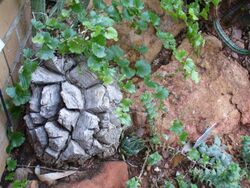Biology:Dioscorea elephantipes
| Dioscorea elephantipes | |
|---|---|

| |
| Scientific classification | |
| Kingdom: | Plantae |
| Clade: | Tracheophytes |
| Clade: | Angiosperms |
| Clade: | Monocots |
| Order: | Dioscoreales |
| Family: | Dioscoreaceae |
| Genus: | Dioscorea |
| Species: | D. elephantipes
|
| Binomial name | |
| Dioscorea elephantipes (L'Hér.) Engl.
| |
Dioscorea elephantipes, the elephant's foot or Hottentot bread, is a species of flowering plant in the genus Dioscorea of the family Dioscoreaceae, native to the dry interior of South Africa .
Description
It is a deciduous climber. It takes the name "elephant's foot" from the appearance of its large, partially buried, tuberous stem, which grows very slowly but often reaches a considerable size, often more than 3 m (10 ft) in circumference with a height of nearly 1 m (3 ft 3 in) above ground. It is rich in starch, whence the name Hottentot bread, and is covered on the outside with thick, hard, corky plates.[1]
Primarily a winter grower, it develops slender, leafy, climbing shoots[1] with dark-spotted, greenish-yellow flowers in winter (May or June in habitat)[2] The flowers are dioecious, with male or female flowers occurring on separate plants.
Distribution
Its natural habitat is the arid inland regions of the Cape, stretching from the centre of the Northern Cape (where it occurs around Springbok), south to the Clanwilliam & Cederberg area, and eastwards through the districts of Graaff Reinet, Uniondale and Willowmore, as far as Grahamstown.
It was recently rediscovered in a section of the Northern Cape Province by an expedition collecting seeds for the Millennium Seed Bank Project.[3]
In this area, it is most common on rocky north & east-facing slopes, in quartz or shale based soils.[4][5]
Cultivation
This species is not difficult to cultivate, however it requires extremely coarse, well-drained soil, and sparse watering. Importantly, it is deciduous and loses its leaves in the summer. At this time it goes through a dry dormancy period. It has gained the Royal Horticultural Society’s Award of Garden Merit.[6][7]
Watering
This species indicates when it is requiring water, by the presence of green growth. From when a new growth appears from the caudex, it can receive regular watering, up until the growth withers and dies back. This is when the plant goes into its summer dormancy. Then watering should become more rare – until the next new growth appears.
The cycle can be extremely unpredictable or erratic, but in most cases this results in a watering regime of wetter winter and spring, and a dry summer dormancy period.[8]
Sun and shade
In nature, the caudex is usually in shade beneath thicket vegetation, and only the leafy tendrils reach up to the sunlight. Therefore, the caudex is sensitive to prolonged exposure to heat and full sunlight, and a dappled-sun or semi-shaded position is preferable. The green vine tendrils however, thrive if they are able to reach partial or full sunlight.[9]
Soil
This plant grows naturally in brush on rocky slopes, so it requires extremely well-drained soil, with a large (at least 50%) mineral component.
Temperatures
In cultivation in temperate areas, D. elephantipes can tolerate temperatures to −4 °C in habitat.
Gallery
References
- ↑ Jump up to: 1.0 1.1
 One or more of the preceding sentences incorporates text from a publication now in the public domain: Chisholm, Hugh, ed (1911). "Elephant's-foot". Encyclopædia Britannica. 9 (11th ed.). Cambridge University Press. p. 262.
One or more of the preceding sentences incorporates text from a publication now in the public domain: Chisholm, Hugh, ed (1911). "Elephant's-foot". Encyclopædia Britannica. 9 (11th ed.). Cambridge University Press. p. 262.
- ↑ "Dioscorea elephantipes (L'Her.) Engl.". April 2005. http://www.plantzafrica.com/plantcd/dioscoreleph.htm.
- ↑ http://powo.science.kew.org/taxon/urn:lsid:ipni.org:names:317936-1
- ↑ "Dioscorea elephantipes | PlantZAfrica.com". http://www.plantzafrica.com/plantcd/dioscoreleph.htm.
- ↑ "Threatened Species Programme | SANBI Red List of South African Plants". http://redlist.sanbi.org/species.php?species=1777-12.
- ↑ "RHS Plantfinder - Dioscorea elephantipes". https://www.rhs.org.uk/Plants/5913/i-Dioscorea-elephantipes-i/Details. Retrieved 12 February 2018.
- ↑ "AGM Plants - Ornamental". Royal Horticultural Society. July 2017. p. 16. https://www.rhs.org.uk/plants/pdfs/agm-lists/agm-ornamentals.pdf. Retrieved 24 January 2018.
- ↑ "Dioscorea elephantipes". http://www.botanicwonders.com/Features-Dioscorea-elephantipies.html.
- ↑ PlantZAfrica.com article
- {{citation
| mode = cs1 | title = Dioscorea elephantipes | work = Germplasm Resources Information Network (GRIN) | url = | publisher = [[Organization:Agricultural Research ServAgricultural Research Service (ARS), United States Department of Agriculture (USDA) | access-date = }}
Wikidata ☰ Q3023510 entry
 |




